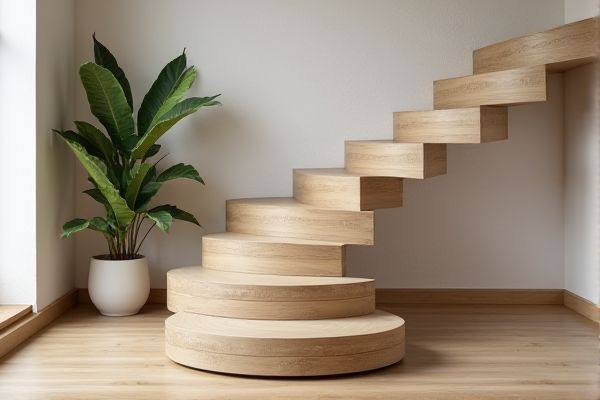
Balanced treads ensure even weight distribution and optimal traction, reducing wear and increasing safety, while uneven treads lead to poor vehicle handling and accelerated tire degradation. Discover which tread type suits Your driving needs and how to maintain them in the full article.
Table of Comparison
| Feature | Balanced Treads | Uneven Treads |
|---|---|---|
| Definition | Steps with uniform height and depth | Steps with varying height or depth |
| Safety | Higher safety due to consistent step size | Lower safety risk; increased chance of tripping |
| Comfort | Comfortable and predictable walking experience | Uneven feel leading to discomfort and fatigue |
| Usage | Common in residential and commercial stairs | Rare; sometimes used for aesthetic or terrain adaptation |
| Installation Complexity | Standardized, easier installation | Complex; requires precise customization |
| Cost | Generally cost-effective | Higher cost due to customization |
Introduction to Stair Treads: Balanced vs. Uneven
Balanced stair treads ensure uniform depth and height, promoting safety and comfortable foot placement on each step. Uneven treads, characterized by inconsistent rise and run measurements, increase the risk of trips and falls due to unpredictable footing. Properly measured and installed balanced treads enhance staircase stability and comply with building codes.
What Are Balanced Treads?
Balanced treads feature uniform thickness and consistent spacing, ensuring even weight distribution and optimal traction on stairs. This design reduces the risk of slips and falls, promoting safety and comfort for Your daily use. Uneven treads, by contrast, can cause discomfort and increase the likelihood of accidents due to irregular step heights or surfaces.
Defining Uneven Treads
Uneven treads refer to steps in a staircase that vary in depth, height, or width, disrupting the consistency required for safe and efficient navigation. These irregularities can cause increased tripping hazards and strain due to unpredictable foot placement. Balanced treads, in contrast, maintain uniform dimensions that promote stability and reduce the risk of accidents.
Safety Implications of Tread Design
Balanced treads provide uniform traction and stability, reducing the risk of slips, trips, and falls, which significantly enhances safety on staircases and walkways. Uneven treads may cause inconsistent footing, increasing the likelihood of missteps and accidents, especially in high-traffic or low-light areas. Ensuring your tread design is balanced is critical for maintaining safe pedestrian environments and preventing injury.
Ergonomics: Comfort and Usability
Balanced treads provide consistent foot placement, reducing strain and enhancing overall comfort during prolonged use. Uneven treads can cause misalignment and increase the risk of fatigue or injury due to inconsistent pressure distribution. Ergonomically designed balanced treads improve usability by promoting natural gait and reducing muscle stress.
Building Codes and Regulations on Stair Treads
Building codes and regulations require stair treads to have consistent dimensions to ensure safety and prevent tripping hazards. Uniform tread depth and height are mandated by standards such as the International Building Code (IBC) and OSHA regulations, specifying maximum variation limits typically around 3/8 inch (9.5 mm). Uneven treads often violate these codes, leading to potential building inspection failures and increased liability risks.
Aesthetic Impact: Balanced vs. Uneven Treads
Balanced treads create a harmonious and visually pleasing staircase, enhancing the overall aesthetic appeal by providing uniformity and rhythm in design. Uneven treads disrupt this flow, often resulting in a chaotic and uncoordinated appearance that can detract from architectural elegance. Consistent tread sizing ensures comfort, safety, and a polished look that complement both modern and traditional interiors.
Cost and Material Considerations
Balanced treads typically require higher-quality materials such as premium rubber or composite compounds, resulting in increased initial costs but enhanced durability and long-term performance. Uneven treads are often manufactured with less expensive materials, leading to lower upfront prices but potentially faster wear and more frequent replacements. Material composition directly influences both the cost efficiency and longevity of the tread design, making balanced treads a more cost-effective investment over time despite their higher initial expense.
Maintenance and Longevity Factors
Balanced treads promote even wear and reduce the risk of premature tire damage, extending the overall tread life compared to uneven treads that cause irregular wear patterns. Uneven treads often lead to increased maintenance needs, such as frequent alignments and rotations to prevent handling issues and safety risks. Maximizing Your tire longevity depends on maintaining properly balanced treads to optimize wear distribution and reduce repairs.
Choosing the Right Tread Design for Your Space
Balanced treads offer uniform steps that enhance safety and comfort, making them ideal for residential and high-traffic areas. Uneven treads, while sometimes used for aesthetic or custom designs, can pose tripping hazards and reduce stability. Choosing the right tread design for your space depends on prioritizing safety, user experience, and the specific architectural requirements of your staircase.
 homyna.com
homyna.com